There are 4 types of lung cancer. You should know 3 small symptoms that may indicate lung cancer.

|
Most lung cancers originate from the bronchial mucosal epithelium, also known as bronchial lung cancer. Currently, lung cancer is one of the malignant tumors with the fastest growing incidence in my country. In some European and American countries or large cities in my country, the incidence has jumped to the first place among various tumors in men. Most lung cancer patients are male, and the ratio between men and women is about 5:1. Currently, the incidence of lung cancer in women is growing faster than that in men, and the age of onset is mostly over 40 years old. The cause of lung cancer has not yet been fully clarified, but the cause of the disease is closely related to some factors, such as smoking, air pollution, industrial dust, and factors in the human body. Lung cancer originates from the bronchial mucosal epithelium. The tumor can grow into the inside and outside of the bronchial lumen and adjacent lung tissue, and spread and metastasize through the lymphatic, blood or bronchi. In July 1998, the International Association for the Study of Lung Cancer revised the lung cancer case and divided lung cancer into nine categories according to cell type: squamous cell carcinoma, small cell carcinoma, adenocarcinoma, large cell carcinoma, squamous cell adenocarcinoma, pleomorphic, sarcomatoid or sarcomatous cancer, carcinoid, salivary gland cancer, and unclassified cancer. The following four are the most common clinically. The first is squamous cell carcinoma, which is the most common type of lung cancer. It occurs mostly in men and most originate from larger bronchi. It grows more slowly in the lungs and has a longer course. It usually metastasizes through the lymph nodes, and blood metastasis occurs later. The second type is small cell carcinoma, which has a lower incidence rate than squamous cell carcinoma. It occurs more frequently in young people and is generally more common in male patients. This disease originates from the larger bronchi. Small cell carcinoma is more malignant, grows faster, and has extensive lymphatic or blood metastasis at an earlier age. The third type is adenocarcinoma, which is relatively more common in women. Most originate from the smaller bronchial epithelium. This type of tumor grows slowly and lymph node metastasis occurs relatively late, but some small tumor foci will have hematogenous metastasis. The fourth type is large cell carcinoma. This type of cancer is relatively rare. About half of them originate from the large bronchi. Large cell carcinomas are relatively poorly differentiated and are prone to hematogenous metastasis. The symptoms of lung cancer are related to the location, size, whether it compresses and invades adjacent organs, and whether it has metastasized. In the early stages, peripheral lung cancer occurs in the bronchial mucosal epithelium and often has no symptoms. Early central lung cancer originates from larger bronchi, and patients may have intermittent coughs and blood in sputum. When the tumor grows in the larger bronchi, irritating dry coughs often occur, and anti-infection and cough suppressant treatments are not effective. Another common symptom is bloody sputum, usually with blood spots, blood streaks, or intermittent small amounts of hemoptysis in the sputum, while large amounts of hemoptysis are rare. When the larger bronchi are blocked to varying degrees, symptoms such as chest tightness, shortness of breath, fever, chest pain, and wheezing may occur. In addition to systemic symptoms such as loss of appetite, weight loss, fatigue, and other systemic symptoms, advanced lung cancer may also have symptoms of lung cancer compressing adjacent organs and tissues or metastases. Patients with lung cancer must know the importance of preventing respiratory infections. They should avoid going to public places or contact with people with upper respiratory tract infections for a period of time after surgery, and avoid contact with smoke and chemical irritants. If a respiratory infection occurs, they should go to the hospital as soon as possible to seek medical treatment. They should understand the dangers of smoking and encourage patients to quit smoking. If they experience symptoms such as wound pain, severe coughing, and hemoptysis, they should go to the hospital for treatment as soon as possible. |
<<: Will primary liver cancer be painful if it is 1cm? How to treat primary liver cancer
Recommend
Does eating taro cause bloating?
Many people have unhealthy stomachs. After eating...
The main measures to prevent the continuous occurrence of gastric cancer
Gastric cancer is one of many cancer diseases, an...
Will it hurt when wisdom teeth grow?
Teeth are very important to people. Wisdom teeth ...
Will a high fever damage the brain?
We often hear that high fever can damage the brai...
Is mild pulmonary valve regurgitation serious?
If people have lung diseases, they must find ways...
What are the symptoms of skin cancer
Skin cancer is a type of malignant tumor that occ...
Is microcrystalline stone good
Microcrystalline stone is a new type of building ...
Most ovarian cancer patients will have symptoms of no changes in menstruation
Usually, the symptoms of ovarian cancer are not e...
How to fry peanuts in an electric baking pan?
Peanuts have many benefits to the human body. The...
What are the reasons for sudden weight loss
Some people have had this experience, where they ...
How to detect pancreatic cancer early
Pancreatic cancer is one of the most malignant tu...
How to remove oil stains from clothes
In our daily lives, we cannot avoid contact with ...
What is the reason for the heartache on the right foot
Pain in the right sole of the foot may be caused ...
What is cervical vertebra resection
Cervical conization is suitable for some patients...
Calf cramps when sleeping at night
Many people experience intermittent cramps in the...









